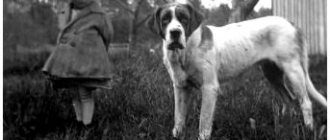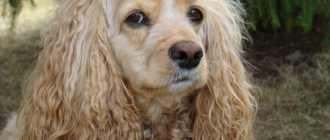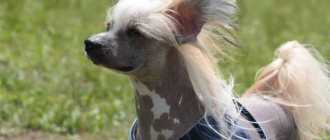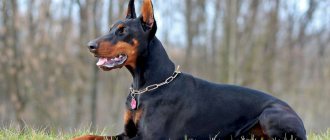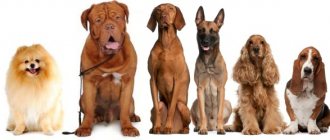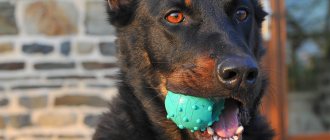There are two versions of the origin of pharaoh dogs. According to one of them, Malta is considered to be their homeland, and another says that dogs of this breed appeared 4 thousand years before the birth of Christ in Egypt. Today, the real homeland of the Pharaoh Hound is Malta.
Initially, these dogs were hunting dogs. They hunted, as a rule, rabbits. Even now, the inhabitants of Malta have a holiday called the “rabbit riot”, in which the whole country walks, and attention is focused on the kings of the holiday - the pharaoh dogs.
This breed came to Europe only in the 20s of the twentieth century, and gained its popularity fifty years later. The main character traits of the pharaohs can be safely called willfulness and independence . As a rule, in a family they choose one person and obey only him. Despite this, they cannot stand loneliness and love active games. The Pharaoh Hound is not aggressive unless you make it angry.
Without exception, all pharaoh dogs can blush . This is due to the structural features of the blood vessels. When a dog is embarrassed or happy, its nose and ears turn pink.
They have excellent health . But sometimes puppies are born with congenital diseases: dislocations of the knee joints, allergic reactions, volvulus of the stomach or intestines. It is important to understand the fact that almost all pharaoh dogs are allergic, and self-treatment can be fatal; they need qualified veterinary care.
They are also unpretentious in care. They are self-sufficient and clean. A mandatory procedure is regular brushing of the coat, because dogs of this breed shed all year round.
Thus, the breed rating is as follows:
- Security qualities: 3/5.
- Character: 4/5.
- Health: 4/5.
- Care: 5/5.
- Personality: 4/5.
Pharaoh dogs sense their owner and all changes in his mood. With due attention and patience, they learn quickly, so only you can make a loyal friend and helper out of her.
History of the breed
Despite the catchy name, these dogs are not related to Ancient Egypt. Their homeland is the island state of Malta. It was here that the first description of the rabbit hunting dog, Kelb tal-Fenek, was given in 1647. The ignorant islanders had the right to freely hunt only rabbits, for which they actively used these dogs.
At the beginning of the 20th century, the first representatives of the breed ended up in England, but were not appreciated. Pharaoh dogs gained worldwide fame only in the 70s. In 1975 the breed was officially recognized.
The bright name for the dogs of the Egyptian pharaohs was invented by the British, struck by the external resemblance of the animals to the god Anubis, the guide of the dead to the kingdom of the dead.
He was depicted with the head of a jackal, which surprisingly resembles the profile of pharaoh dogs - the same elongated head, the same large, erect ears.
But DNA tests confirm that their genome does not match that of ancient Egyptian hounds.
Health
On average, Pharaoh Hounds can live 15-17 years. With proper care, the life span is extended to 18 and even 19 years.
By nature, the pharaoh is blessed with good health and has a strong immune defense. It is interesting that even at a respectable, one might say, senile age, this pet is distinguished by its excellent physical shape and playful, cheerful disposition.
It is important to take your dog to the veterinarian every year for preventive examinations. At the clinic you need to take tests and undergo an x-ray examination.
These actions will help to detect the disease in time and begin treatment at an early stage, which is the key to a quick recovery.
The owner of the pharaoh must carry out deworming, vaccination and treatment for skin parasites.
It is worth noting that representatives of the breed do not tolerate flea medications very well, and also react poorly to flea collars. You need to select these products very carefully, monitor the animal’s reaction and consult a veterinarian.
Despite its strong body, the Pharaoh Hound, although rarely, gets sick. This species is prone to the following health problems:
- Dislocations are more often congenital.
- Joint dysplasia – characterized by severe pain and lameness. Requires treatment, otherwise the dog may lose the ability to move.
- Gastrointestinal diseases - volvulus, bloating, diarrhea.
- Allergies – most often occur to any chemicals or detergents.
- Ear infections.
- Von Willebrand's disease is a blood clotting disorder.
- Hypothyroidism is a disorder of the thyroid gland.
External data
When studying photos of pharaoh dogs, you can immediately see what strong, powerful animals they are with an athletic build and well-developed muscles. At the same time, they are full of grace, elegance, and royal stature.
Dog height is 52-62 cm, weight is 18-27 kg.
How to choose a puppy
The choice of a puppy should be taken with full responsibility. Since the dog is quite rare and it is almost impossible to find one on the street, it will not be easy to find breed specialists. You will have to carefully study the information about all nurseries involved in breeding Pharaoh Hounds. Read reviews and look at the pedigrees of the dogs. It’s not worth buying a puppy of a rare breed from your own hands, the likelihood of deception is too high, and instead of an elite breed pet, you can buy a mestizo or even a mongrel.
Head
The head is elongated, clearly defined, sitting on a muscular neck. The nose is large, pinkish-flesh in color. The eyes are medium-sized, honey-amber in color to match the overall color.
The look is intelligent, lively, interested. Pharaoh Hound puppies are born with blue eyes. By 2.5 months, the iris becomes yellowish, and as it matures it acquires a characteristic amber hue.
A striking breed feature is large, erect ears with pointed tips. They are very active and tend to turn red when the dog is excited or happy. The nose and eye rims also turn red.
And the “pharaohs” know how to wrinkle their noses in a funny way and smile, raising the corners of their lips.
Price
The Pharaoh Hound is a rare, valuable and quite expensive breed.
The average price of a puppy is about a thousand dollars. A descendant of eminent parents with a prestigious pedigree will cost even more - about 1.5 - 5 thousand dollars.
The Pharaoh Hound is an amazing animal - beautiful, intelligent and mysterious. Representatives of this breed are not demanding in care.
However, if the owner is able to surround the pet with care and attention and create good conditions for it, the dog will respond with boundless devotion and give a sea of positive emotions to the whole family!
Frame
The body is elongated, lean, with developed muscles, the back is almost straight. The limbs are long and strong with pronounced hock joints.
The paws are strong, with tightly pressed toes and hard pads. The tail is whip-shaped, wide at the base, tapering towards the tip. At rest it hangs down to the hocks; at the moment of excitement it rises, taking the shape of a sickle.
Hygiene
The animal's short coat requires regular brushing with a rubber brush. The molting period (autumn and spring) passes almost unnoticed.
A pleasant feature of this breed is that the wool, even when wet, does not emit a characteristic “dog” smell. The “Pharaoh” should be washed as it gets dirty, but at least once every six months.
Particular attention should be paid to the quality of detergents. These dogs often have allergic reactions to chemicals. For washing, use hypoallergenic puppy shampoos.
Large ears require regular inspection, since during walks small insects and debris can get into them and cause an inflammatory process. If your dog often scratches his ears or rubs them on the floor, this is a reason to consult a veterinarian. As part of regular care, the ears are wiped with a damp swab, and wax deposits are removed as necessary.
After each walk, it is necessary to inspect the paw pads for wounds and abrasions.
Nutrition
Nutrition issues are of fundamental importance in the maintenance of “pharaohs”. To maintain natural activity, they require a balanced diet with a high content of nutrients. Dogs digest both ready-made dry food and food prepared by the owner equally well.
If the first option is preferred, then it should be premium and super-premium food. In this case, you cannot save money; cheap formulas can undermine your pet’s health.
When preparing your own diet, it must include lean meat (veal, beef, rabbit, liver), cereals, vegetables, and moderately fatty dairy products. You can give your pet a raw egg no more than once a week. It is strictly forbidden to treat your dog to smoked meats, baked goods, sweets, or food containing all kinds of spices.
Maintenance and care
Pharaoh dogs are undemanding to space if they lead an active sporting life outside the home. Modern breeders claim that keeping an “anubis” in an apartment is no more difficult than in a country mansion, if you set the correct daily routine for the animal. Keep in mind that the breed is sensitive to low temperatures (they come from hot Malta, after all), so on frosty days, take the dog for a walk in insulated overalls or force him to spend time actively: run races, play with objects, jump. In general, do whatever helps you stay warm.
Pay due attention to the choice of collar. Due to the elongated neck, not all models are suitable for pharaoh dogs, but only the so-called “herring” - a design that has a wide center and narrowed edges. And please, no harnesses or chains, if you don’t want to choke your pet running after a stray cat. But you don’t have to look for a suitable lounger at all - at home, rabbit greyhounds still prefer to lie on armchairs and sofas, stubbornly ignoring the mattresses bought for them.
Hygiene
In terms of accuracy, pharaoh dogs have no equal. Representatives of this clan always find a way to avoid a dirty puddle and even in the most inclement weather they manage to return from a walk in a neat appearance. Moreover, the Pharaoh Hound is one of those rare image breeds whose representatives do not need to be combed, trimmed or cut. The maximum that is required to maintain the coat in a healthy, presentable form is to walk over it once a week with a rubber mitten.
There is no point in washing “pharaohs” too often, but if the animal gets dirty (which is rather nonsense for the breed), you cannot do without taking a bath. The main thing is to carefully ensure that your pet does not have the opportunity to lick the shampoo, which will negatively affect its digestion. By the way, the “Maltese” themselves have a positive attitude towards water and willingly swim under the supervision of the owner. The eyes of representatives of the breed do not require special care: it is enough to remove dust bunnies in the morning and carry out preventive weekly wiping of the eyelid mucosa with an ophthalmic solution.
The ears of Pharaoh dogs are large and open, so they are well ventilated and do not cause problems for their owners. Of course, it is necessary to inspect the inside of the organ, but usually caring for a greyhound’s ears comes down to removing wax from them with a cotton swab or a damp bandage wrapped around tweezers. By the way, due to the excessively sharp bend of the ear canal, it is undesirable for “pharaohs” to instill liquid preparations and herbal lotions inside, since the animal will not be able to get rid of the liquid on its own. Alternatively, you can use drops in tandem with special veterinary powder. After the liquid has entered the ear and dissolved the wax deposits, it is necessary to dry the inside of the organ by adding a small amount of powder. The powder will absorb excess moisture, and the greyhound will be able to remove it from the ear canal on its own by shaking its head.
Once a month, it is recommended for the Pharaoh Hound to shorten the claw plate so that it does not interfere with running, and twice a week to brush its teeth with veterinary paste and a brush with soft bristles or a bandage wrapped around the finger. If you live in the city and during the cold season you walk with your pet along sidewalks strewn with reagents, take care of the paws of your Maltese rabbit greyhound. In particular, upon returning home, rinse them with warm water and lubricate them with nourishing cream.
Walking and coursing
Ideally, a “pharaoh” should spend about three hours a day outside the home walls. All this time he has the right to give free rein to his instincts - to run, jump and play hard. In case of time pressure, the duration of walks can be reduced to two hours a day, but you will definitely have to go outside with your greyhound in the morning and evening. The optimal alternative to hunting, which few people already practice with Maltese “Anubises,” is coursing. Running after a mechanical hare can both exhaust the animal and reveal its innate talents as a breadwinner.
To awaken interest in chasing a mechanical bait, the puppy is teased with game tied to a rope at an early age. As for full preparation for coursing competitions, it is recommended to start at 7 months of age. At this point, the Pharaoh Hound puppy is relatively strong and has built up the necessary muscle mass. The easiest way to teach proper running is with the help of a bicycle: the owner controls the bike, and the four-legged ward, strapped to the frame, runs alongside. The driving pace should constantly alternate from slow to fast. At the same time, it is important to stop in time - the dog should come from training slightly tired, and not fall from exhaustion.
A good substitute for cycling is racing along snowdrifts, sand dunes and beaches. For such training, it is better to take the animal outside of populated areas, since greyhounds consider car trips as pleasant entertainment. Keep in mind that novices are not allowed on adult tracks immediately. First, growing athletes engage in coursing over short distances, since at the dawn of their sports career, pharaoh hounds should run no more than 100-200 m. In addition, in order to avoid excessive stress, the fragile metacarpus of young individuals who are just beginning to comprehend the basics of coursing are bandaged.
Feeding
The breed is modest in its eating habits. In addition, its representatives have sensitive liver and pancreas, which automatically excludes the consumption of fatty foods. Accordingly, if you prefer to feed your pet “natural” food, rely on lean meat, tripe and offal. By the way, the widespread myth that pharaoh dogs respect plant foods more than animal foods remains a myth. Of course, the diet should include “vegetarian” products, but the basis of the greyhound’s menu, like any dog, is meat and its waste.
An important point: the serving size of Pharaoh Hound is not a constant value. The largest plate should be for individuals participating in coursing and other sporting events. The smallest is among the elderly and “Maltese” who lead a passive lifestyle.
To prevent the dog’s nutrition from costing astronomical sums, it is advisable to mix meat into porridges, for example, buckwheat or rice. In summer, it is useful to feed the animal with fruit and vegetable salads with butter or low-fat sour cream. In winter, the lack of vitamins and fiber will have to be replenished with veterinary complexes, as well as dried algae (kelp, fucus). Low-fat cottage cheese, a chicken egg (no more than once a week), boiled fish fillet are the products necessary for proper nutrition of a greyhound.
Many foreign and domestic pharaoh dog breeders have opted for industrial feed. At the same time, it is important to understand that special savings will not be achieved when switching from “natural” to high-quality “drying”. In order for the animal to feel normal and be energetic in the future, you will have to spend money on super premium and holistic varieties with a high content of animal proteins. It is desirable that the composition of the “drying” includes meat, and not by-products of its processing. For example, some manufacturers use leather, feathers and connective tissues to help increase the amount of protein in dry food. However, such protein will not be absorbed by the “pharaohs” body, and therefore will not be beneficial.
Diseases
Thanks to their active lifestyle, Pharaoh dogs are physically very healthy. But there are a number of diseases characteristic of representatives of this breed:
- Dysplasia of flexion joints (hip, knee, elbow). Age-related changes in the structure of cartilage tissue.
- Dislocations of the kneecaps. Occur due to weakness or underdevelopment of ligaments and lead to frequent injuries to the limbs.
- Frequent bloating. Occur due to the weakness of the ligaments that support the internal organs and the gluttony of the dog. May lead to intestinal volvulus.
- Allergic reactions.
In case of any ailments, the “Pharaoh” should be shown to a veterinarian. It is strictly prohibited to independently select medications for your dog.
Due to the propensity of animals for allergies, the consequences of self-medication can be disastrous.
Despite all their unique qualities, “pharaohs” are quite rare animals.
The population numbers just over 5 thousand individuals worldwide. This determines the high price of pharaoh dogs, which ranges from $800 for puppies without a pedigree to $5,000 for elite individuals. To be sure of the physical and mental well-being of your pet, you should purchase it exclusively from specialized nurseries.
Education and training
It’s easy to make friends with a Pharaoh Hound, but you won’t be able to immediately instill in your pet the necessary standards of etiquette, no matter how great friends you are. On the other hand, rabbit greyhounds have a phenomenal memory, and once they learn commands or artistic numbers, they never forget.
It is important to understand that proud “Anubises” cannot stand strict discipline and study, therefore, if you intend to start training, be prepared to spend from several months to several years on this matter. The breed will take many times longer to comprehend the same OKD than any German shepherd, so sometimes it is wiser to abandon complex programs in favor of more simplified options. After all, pharaoh dogs were not bred for service and protection.
To control your pet in a city or hunting environment, a set of elementary commands like “Come to me!”, “Place!”, “Stop!” is enough. and others. If the animal is one of the show animals that are regularly exhibited in the ring, it is worth adding to this kit several specific commands that help present the dog to the commission in a favorable light: “Work!”, “Teeth!”, “Run!”
The style of teaching all skills should be extremely gentle - do not be afraid, the “pharaoh” will not interpret kindness as weakness and will not turn on the alpha male. But it’s better not to get carried away with repetitions of exercises - the breed will not tolerate such tediousness and next time it will try to sneak out of the lesson. An important nuance: the “pharaoh” must be weaned from an early age from raising his voice over trifles. Despite the fact that the Maltese is not hysterical, their barking is loud and annoying, so the less often the dog strains its vocal cords at home, the more comfortable it will be for you.
Animals quickly learn to properly satisfy their toilet needs: pharaoh dogs are naturally very tidy, so in childhood they relieve themselves on newspapers and diapers without any problems, and when they grow up, they do the same thing, but outside the apartment, while walking.
Photo of Pharaoh Hound
Help the project, repost

0

